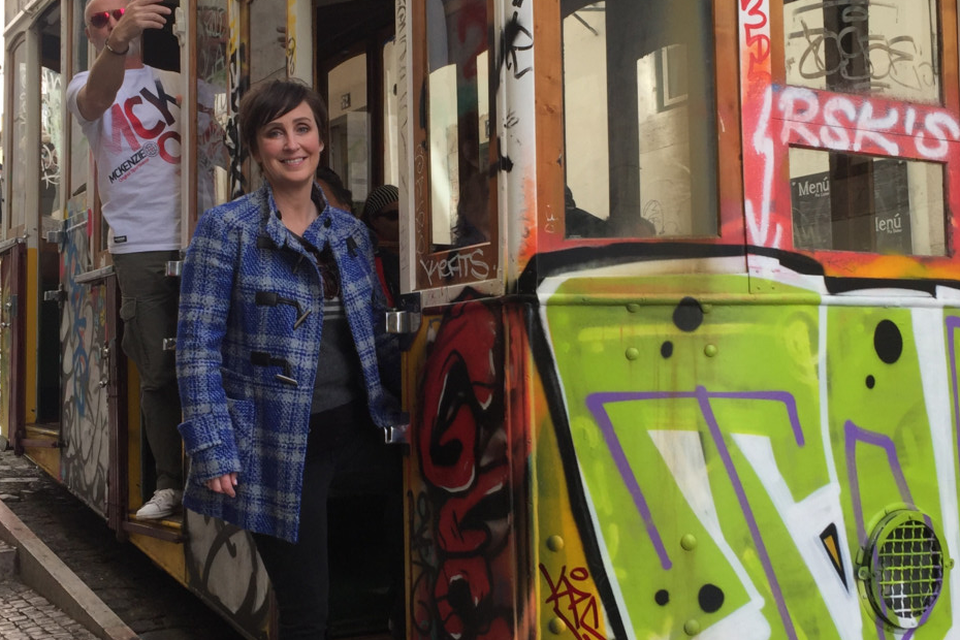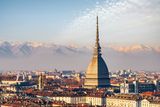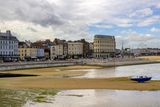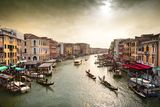Lisbon: A voyage of discovery in the land of light

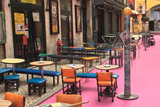
On a recent trip away, I met a proud Portuguese man, and our conversation segued into a discussion of his homeland's illustrious explorers.
"Did you know," he said to me, a mischievous smile playing around his lips, "that Christopher Columbus was actually Portuguese?"
Eh, come again? The great explorer who sailed the ocean blue in 1492 wasn't Italian? Mamma mia! Several months later, I found myself in Lisbon, the Portuguese capital, and on recalling the discombobulating exchange, I wondered if one of the oldest cities in Europe might reveal the truth of the legendary voyager's birth. More of which anon.
Lisbon - a short flight from the easy dream of an airport that is Cork - is one of Europe's most beautiful capitals, and, like Rome, was built on seven hills; the landmark St George's Castle is perched on one; the ancient structure can be seen from any vantage point in the city. Lisbon's first settlements date to the Neolithic era, and from those grew the ancient capital of the Roman-conquered land of Lusitania - 'land of light' - due to its strategically important location at the mouth of the mighty Tagus.
The Moors ruled for over two centuries until they were routed by the Knights Templar in 1147 (intriguingly, the sails of Columbus's ship, the Santa Maria, are always depicted emblazoned with the red crosses of the Knights Templar).
Lisbon became the new nation-state's capital in 1255, and a golden era for it and the Portuguese empire endured through the 14th and 15th Centuries, with its fearless explorers discovering and conquering new territories apace, and returning from far-flung lands with untold riches, ranging from spices to gold. Devastation hit in 1755, when an earthquake and tsunami destroyed 90pc of the city, killing over 40,000 Lisbonites on All Saints' Day - leading many to believe it was an act of divine retribution. Thanks largely to the pragmatic Marquis of Pombal, who famously said, "What now? We bury the dead and heal the living", Lisbon was rebuilt, and its new quake-proof buildings, the world's first, still stand.
Cascais which is a short train ride from Lisbon
My first stop in Lisbon was the Romanesque Se (bishop's seat) Cathedral, in the Alfama district, the oldest area of the city. While most of the Alfama did not succumb to the earthquake, the Se, built in 1147 on the ruins of a mosque, was largely destroyed, and renovations did not begin until the 1940s. St Anthony, who was born nearby, is said to have been baptised here, and the beautiful Baroque-tiled font in which he received the sacrament is still in situ. Lisbon is vertiginously hilly, so it's advisable to catch a no 28 tram, an old-style remodelado, which passes outside the door, and then explore in a downhill direction.
Doing so on a Tuesday or Saturday will bring you to Campo de Santa Clara, and the Feira da Ladra flea market, which translates as 'thieves' market' - legend has it that robbers would convene here to offload booty stolen from city folk. It's a vintage lover's dream, with everything from chandelier crystals to vintage clothes on sale - and an abundance of junk, too. Alfama was originally outside the city walls, and has a Moorish vibe, with typically Portuguese azulejo-clad houses in abundance. Azulejos - art tiles - have a practical purpose in that they act as insulation and the colourful ceramics are easy to clean. This democratic art form enjoyed a revival in the 1950s, with new metro stations being clad in the tile art.
A more contemporary experience is to be had in the riverside Alcantara district, once home to the docks, but now a trendy shopping and nightlife area. It's also home to Experience Pilar 7, an interpretive centre attached to 25 de Abril Bridge, a mighty structure that spans the Tagus. Originally called Ponte Salazar, until the Carnations Revolution, the new name reflects the date 48 years of dictatorship ended. There's plenty for history buffs here, and superb views from the 80 metre-high viewpoint. Alcantara is adjacent to Belem, the museum district, which has an abundance of them in its environs. I stopped for lunch at Espelho d'Agua (Mirror on the Water), a polished concrete floor and mid-century-modern furniture type of eatery with excellent food and gorgeous views. Adjacent is the impressive Monument to the Discoveries, a 1960s homage in concrete to the great Portuguese explorers, including Henry the Navigator, Vasco de Gama and Magellan (but no Columbus!). There's a lift to the top for more lofty panoramas.
De Gama's tomb (he discovered the lucrative sea route to India) is in the cathedral of the nearby resting place of royalty, the 16th Century Jeronimos Monastery, the construction of which was paid for in part via a 5pc tax on the spice trade, giving rise to the saying that it was 'built by pepper'. It survived the earthquake, and is also where the famous, delectable pasteis de nata were invented in the 18th Century. The monks starched their clothes with egg white, so the leftover yolks were used in desserts; the sale of the iconic custard tarts proved to be a valuable income stream for the religious brothers. The secret recipe was entrusted to the owners of the nearly Antiga Confeitaria de Belem, who continue to produce the tarts, often some 40,000 per day. If you're not prepared to queue - I wasn't - then the second best pasteis in the city are to be had at Manteigaria in Time Out market, a bustling food-and-drink hub in the regenerated Cais do Sodre neighbourhood. Best eaten with a sprinkling of cinnamon and a bica; an espresso (Lisbonites have a unique coffee lingo; don't insult them by requesting an Americano, ask for um abatanado instead).
Portuguese love their food, and the portions are massive. It's a nation that adores fish, cod in particular - there are no less than 365 recipes for bacalhau (salt cod), despite the fact that cod isn't native to warm Portuguese waters. Petiscos (tapas) are also popular, and delicious with good bread. Dinner that evening was a short cab ride away from my base, the fabulous Jupiter Lisboa Hotel, to Ribadouro, a seafood restaurant that is very much a locals' haunt, judging from the clientele, who seemed to be having a blast. It's a no-frills kind of place, but if it's a crustacean fest you're after, this joint is the mother lode. Lisbon is a city that has embraced modernity, but still retains its authentic charm. My night ended with a few cheeky ports at one of the many outdoor cafe-cum-bars, where the prices are so low, as is the case in Lisbon generally, it's impossible not to do a double take when the bill arrives.
Despite the previous evening's indulgence, I rose early to take a dip in the hotel's rooftop pool (its gorgeous BluSpa also has one), before tucking into the moreish breakfast buffet. That day's itinerary began in Mafra, a small town north-west of Lisbon, with a huge Baroque palace at its heart. Built by John V, it began life as a Capuchin monastery, and took 40 years to complete. The colossal complex houses a basilica, 1,500 rooms and a 36,000-volume library, which is kept free of book-munching insects by a colony of bats - they eat twice their bodyweight in bugs each night, as their ancestors have done for 300 years.
Next stop: the charming village of Chelerios, where, located across from the pillory (to which miscreant villagers were chained and pelted with rotten fruit) is the Manz winery. The region has a long history of wine production; at one point there were 43 wineries in the immediate area. Andre Manz has revived the tradition, and began with Jampal, an almost-extinct grape variety he discovered growing on his newly acquired land. A tasting reveals why this boutique winery has won many awards - its wines are stunning iterations of the grape, not least one that I identify as having a nose of 'dung' - the technical term, I am gently told, is horse sweat.
Lunch is a repast of cod in the quaint fisherman's village of Ericeira, renowned for seafood and surfing, and then it's on to Sintra, an area beloved by the Portuguese upper classes, who built summer residences here to enjoy the refreshing microclimate of the pine-covered hills. You could easily spend the day exploring and have delights left over, but time dictated just one stop, the singular Palace of Pena. In the 19th Century, King Ferdinand commissioned the fairytale castle on the site of a medieval chapel. A masterpiece of romanticism, it took 45 years to build and was completed the year of his death. The exterior is replete with carved allegorical figures, while the lavish interior is one flight of fancy after another, with elaborate trompe l'oeil, intricate carving and tilework in the many themed rooms. The grounds are also enchanting, and packed with exotic blooms and sylva, although a lengthy downpour put paid to any outdoor exploration.
The route back to Lisbon took in Cascais, a pretty seaside resort on the Estoril Coast, and an ideal option for a combined beach and city break if staying in the capital. Dinner was at the Farol, a five-star design hotel, perched on the rocks overlooking Portugal's most famous bay. Farol means lighthouse, and nearby stands a blue and white beacon, the light of which reputedly guided Columbus's caravels to safe harbour after their voyage to the New World. The hotel itself, an extended mansion which once belonged to an aristocrat, is a sublime mix of 19th Century architecture and modern design, with a saltwater pool, and art and design pieces throughout. Dinner is in The Mix (there's also a sushi restaurant), a stylish glazed space that showcases the spectacular sea views, a fitting backdrop to the ensuing fine-dining feast. Farol would make a dream wedding venue, and would be top of my list had that ship not already sailed, so to speak.
My final day in Lisbon dawns bright and sunny. Traversing the mosaicked boulevards, I pass through the Chaido and Bairro Alto districts, legendary for nightlife; and continue to Baxia, the main shopping district, and an area that was completely rebuilt by the aforementioned Marquis of Pombal. Here is Comercio Square, a grand expanse of plaza flanked on three sides by galleried buildings, while the fourth is open to the Tagus, where in times past galleons unloaded their goods at the 'door' to Lisbon.
As we sit for lunch at Populi, a fab people-watching spot on the square, I ask my guide, Carmo Botelho, if there is any truth to my Portuguese pal's claim about Columbus. It seems respected academics believe he was a Portuguese nobleman, and acted as a double agent between the Portuguese and Spanish courts in order to trick the latter away from the valuable Indian trade routes. But the truth may never be known, and maybe that's how the elusive voyager wanted it, certain, perhaps that Lisbon, the city which launched a thousand ships, would woo many explorers in his wake.
Take Two: Top attractions
Nightlife
The pink painted street
Cais do Sodre used to be Lisbon's seediest area, but now it out-hips the legendary Bairro Alto district. Its Rua Nova do Carvalho, a pink-painted street, comes alive after 2am. Go to the funky grafitti-ed bar, Pensao Amor - which pays homage to the sailors who frequented the establishment, when it was a cheap pension with rooms to rent by the hour.
Lisbon Oceanarium
The Oceanarium
If you find yourself in Lisbon with kids, the Oceanarium is a must-see. The largest in Europe, it's packed to the gills with sea creatures of all description - don't miss the playful otters or the penguins' feeding time.
Getting there
Gemma catching an old city train
For more information on what to see and do in Lisbon, see www.visitlisboa.com.
Aer Lingus operates a twice-weekly service from Cork to Lisbon, year-round. Fares start from €39.99 one-way, including taxes and charges. See www.aerlingus.com for further information.
Gemma Fullam was recently named the 'Best Short-Haul Writer' at the Travel Extra Travel Journalist of the Year Awards.
This feature originally appeared in The Sunday Independent.
Join the Irish Independent WhatsApp channel
Stay up to date with all the latest news
